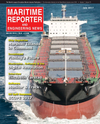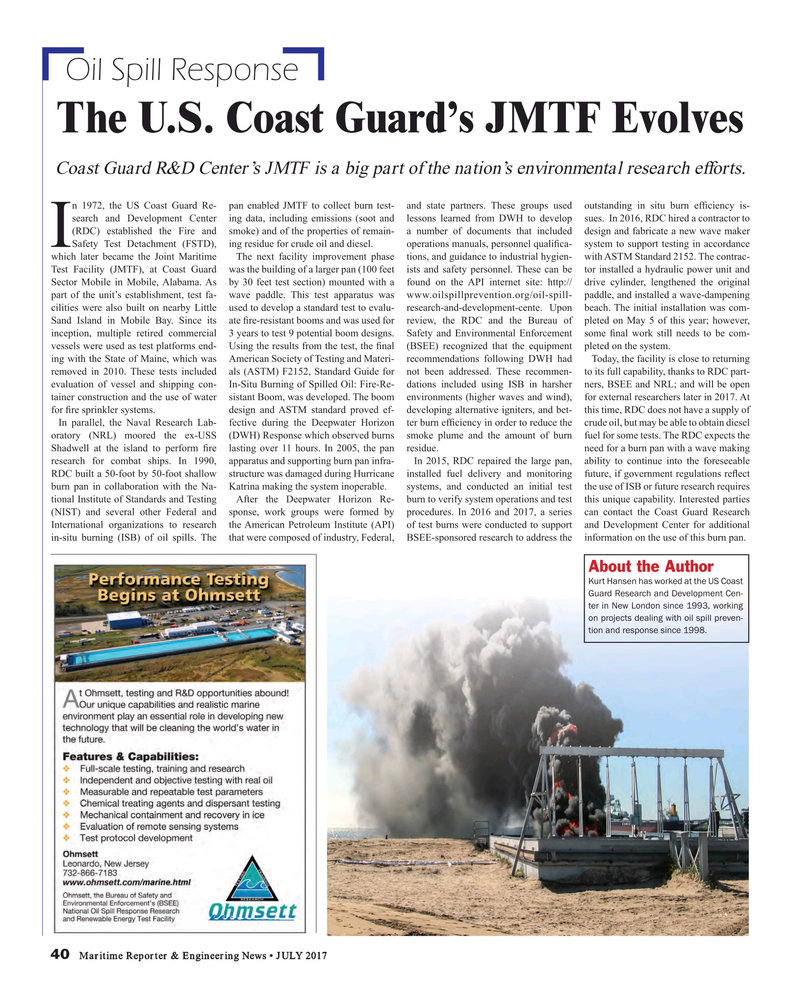
Page 40: of Maritime Reporter Magazine (July 2017)
The Marine Communications Edition
Read this page in Pdf, Flash or Html5 edition of July 2017 Maritime Reporter Magazine
Oil Spill Response
The U.S. Coast Guard’s JMTF Evolves
Coast Guard R&D Center’s JMTF is a big part of the nation’s environmental research efforts.
n 1972, the US Coast Guard Re- pan enabled JMTF to collect burn test- and state partners. These groups used outstanding in situ burn ef? ciency is- search and Development Center ing data, including emissions (soot and lessons learned from DWH to develop sues. In 2016, RDC hired a contractor to (RDC) established the Fire and smoke) and of the properties of remain- a number of documents that included design and fabricate a new wave maker
ISafety Test Detachment (FSTD), ing residue for crude oil and diesel. operations manuals, personnel quali? ca- system to support testing in accordance which later became the Joint Maritime The next facility improvement phase tions, and guidance to industrial hygien- with ASTM Standard 2152. The contrac-
Test Facility (JMTF), at Coast Guard was the building of a larger pan (100 feet ists and safety personnel. These can be tor installed a hydraulic power unit and
Sector Mobile in Mobile, Alabama. As by 30 feet test section) mounted with a found on the API internet site: http:// drive cylinder, lengthened the original part of the unit’s establishment, test fa- wave paddle. This test apparatus was www.oilspillprevention.org/oil-spill- paddle, and installed a wave-dampening cilities were also built on nearby Little used to develop a standard test to evalu- research-and-development-cente. Upon beach. The initial installation was com-
Sand Island in Mobile Bay. Since its ate ? re-resistant booms and was used for review, the RDC and the Bureau of pleted on May 5 of this year; however, inception, multiple retired commercial 3 years to test 9 potential boom designs. Safety and Environmental Enforcement some ? nal work still needs to be com- vessels were used as test platforms end- Using the results from the test, the ? nal (BSEE) recognized that the equipment pleted on the system.
ing with the State of Maine, which was American Society of Testing and Materi- recommendations following DWH had Today, the facility is close to returning removed in 2010. These tests included als (ASTM) F2152, Standard Guide for not been addressed. These recommen- to its full capability, thanks to RDC part- evaluation of vessel and shipping con- In-Situ Burning of Spilled Oil: Fire-Re- dations included using ISB in harsher ners, BSEE and NRL; and will be open tainer construction and the use of water sistant Boom, was developed. The boom environments (higher waves and wind), for external researchers later in 2017. At for ? re sprinkler systems. design and ASTM standard proved ef- developing alternative igniters, and bet- this time, RDC does not have a supply of
In parallel, the Naval Research Lab- fective during the Deepwater Horizon ter burn ef? ciency in order to reduce the crude oil, but may be able to obtain diesel oratory (NRL) moored the ex-USS (DWH) Response which observed burns smoke plume and the amount of burn fuel for some tests. The RDC expects the
Shadwell at the island to perform ? re lasting over 11 hours. In 2005, the pan residue. need for a burn pan with a wave making research for combat ships. In 1990, apparatus and supporting burn pan infra- In 2015, RDC repaired the large pan, ability to continue into the foreseeable
RDC built a 50-foot by 50-foot shallow structure was damaged during Hurricane installed fuel delivery and monitoring future, if government regulations re? ect burn pan in collaboration with the Na- Katrina making the system inoperable. systems, and conducted an initial test the use of ISB or future research requires tional Institute of Standards and Testing After the Deepwater Horizon Re- burn to verify system operations and test this unique capability. Interested parties (NIST) and several other Federal and sponse, work groups were formed by procedures. In 2016 and 2017, a series can contact the Coast Guard Research
International organizations to research the American Petroleum Institute (API) of test burns were conducted to support and Development Center for additional in-situ burning (ISB) of oil spills. The that were composed of industry, Federal, BSEE-sponsored research to address the information on the use of this burn pan.
About the Author
Kurt Hansen has worked at the US Coast
Guard Research and Development Cen- ter in New London since 1993, working on projects dealing with oil spill preven- tion and response since 1998. 40 Maritime Reporter & Engineering News • JULY 2017
MR #7 (34-41).indd 40 MR #7 (34-41).indd 40 7/6/2017 3:52:13 PM7/6/2017 3:52:13 PM

 39
39

 41
41
